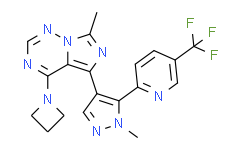| Cas No.: | 1394033-54-5 |
| Chemical Name: | 4-(1-Azetidinyl)-7-methyl-5-[1-methyl-5-[5-(trifluoromethyl)-2-pyridinyl]-1H-pyrazol-4-yl]-imidazo[5,1-f][1,2,4]triazine |
| SMILES: | N1(C2C3=C(C4C=NN(C)C=4C4C=CC(C(F)(F)F)=CN=4)N=C(C)N3N=CN=2)CCC1 |
| Formula: | C19H17F3N8 |
| M.Wt: | 414.387092351913 |
| Purity: | >98% |
| Sotrage: | 2 years -20°C Powder, 2 weeks 4°C in DMSO, 6 months -80°C in DMSO |
| Description: | PF-05180999 is a phosphodiesterase 2A (PDE2A) inhibitor, with an IC50 of 1.6 nM. |
| Target: | PDE2A:1.6 nM (IC50) PDE10A1:2.03 μM (IC50) PDE11A4:26.969 μM (IC50) PDE7B:50.09 μM (IC50) |
| In Vivo: | PF-05180999 (Compound 30; 0.032-0.32 mg/kg mg/kg, s.c.) dramatically reduces the working memory errors produced by ketamine in a working memory radial arm maze (RAM) model in rats. PF-05180999 causes acute and exposure-dependent elevation in the accumulation of cGMP bulk levels in the cortex, striatum, and hippocampus, but with no changes in cAMP and the associated downstream phospho-cAMP response element-binding protein (p-CREB) in mice[1]. |
| In Vitro: | PF-05180999 is a phosphodiesterase 2A (PDE2A) inhibitor, with an IC50 of 1.6 nM. PF-05180999 binds to the rat, dog and monkey PDE2A, with Kis of 4.2, 8.4, and 5.5 nM and IC50s of 2.6, 5.2, and 3.4 nM, respectively. PF-05180999 shows weak activity against PDE, with IC50s of 2.03 μM (PDE10A1), 26.969 μM (PDE7B), 50.09 μM (PDE11A4), and >56.25 μM (PDE1B1, PDE3A1, PDE4D3, PDE5A1, PDE6 (bovine), PDE8B, PDE9A1), respectively. PF-05180999 is also a weak inducer of CYP3A4, and with no direct inhibition of human recombinant cytochrome P450 (CYP) enzymes (1A2, 2B6, 2C8, 2C9, 2C19, 2D6, and 3A) and no induction of CYP1A2[1]. |
| Animal Administration: | Rats[1] Male Sprague-Dawley rats (weighing 250-320 g) under urethane anesthesia at 1.5 g/kg intraperitoneal (ip) are placed in a stereotaxic frame, where craniotomies are performed above the region of the medial prefrontal cortex (mPFC) and ipsilateral (CA)1/subiculum. Body temperature of the rat is maintained at 37°C with an electrical heating pad. The femoral vein is cannulated for administration of test drugs (PF-05180999, etc.). After the conclusion of the experiments animals are euthanized with an iv bolus of urethane[1]. |
| References: | [1]. Helal CJ, et al. Identification of a Potent, Highly Selective, and Brain Penetrant Phosphodiesterase 2A Inhibitor Clinical Candidate. J Med Chem. 2018 Feb 8;61(3):1001-1018. |






















